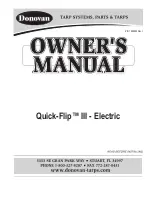
D 900 AP / D 1000 AP / D 1000 APG
8
(fi
g.
4)
(fi
g.
3)
(fi
g.
2)
(fi
g.
1)
• Check that the resistance of the ground on which you are driving is sufficient for the
loaded dumper, in particular on access to bridges, embankments, slabbed areas,
loading areas, etc
(fig. 1)
.
• Before reversing the dumper, the operator should check that doing so will not put at
risk either the machine itself or nearby people or objects.
(fig. 2)
• Do not drive with the cargo box elevated.
• Do not activate two cargo box movements simultaneously.
• Keep your mind completely on the job in hand. The safety of both the driver and
others depends on the care taken when driving.
(fig. 3)
• Depending on the ground, try to raise as little dust as possible while moving about.
• The dumper is not a machine designed for towing other dumpers. If this is
unavoidable, place a certain amount of load in the cargo box to ensure traction.
• Drive carefully and at a reduced speed; and if the tow load is not fitted with an inertia
brake, make sure that the brakes are strong enough for both the dumper mass and
that of the tow load.
• If the dumper has the possibility of two axle traction, consider that this must only be
connected when required for surmounting a sloping obstacle or a slippery surface.
Drive at a reduced speed in order to preserve the tyres and do not subject the
traction-steering unit to excessive workloads.
Take care when loading and unloading the dumper...
• Do not empty the contents of the cargo box near a bank which is not reinforced, and
unless there is a safety stop bar for the wheels at a safe distance from the edge. An
8cm side boarding cannot be considered an acceptable stopping device
(fig. 4)
.
• When tipping the load of a dumper, the centre of gravity continually moves and
the condition of the ground and the prudence of the operator are essential for the
stability of the machine.
• When the dumper is loaded by shovel, crane or other similar external methods, the
driver must leave the cab.
(fig.1 next page)
• Perform the unloading manoeuvre progressively, maintaining the stability of the
dumper.
Avoid transporting materials which would stick to the dumper (for example: clayey
loam) or that would get stuck in the dumper (for example: blocks of stone), as the
loss of control which may be produced in the tipping manoeuvre places the stability
of the dumper at risk.
Special
safety
messages
Summary of Contents for D 1000 AP
Page 1: ...D 900 AP D 1000 AP D 1000 APG OPERATOR S MANUAL ENGLISH ORIGINAL MANUAL ...
Page 2: ......
Page 3: ...D 900 AP D 1000 AP D 1000 APG Above chassis number 63163011 ORIGINAL MANUAL ...
Page 4: ......
Page 13: ...D 900 AP D 1000 AP D 1000 APG 11 Identification plates and labels ...
Page 63: ...D 900 AP D 1000 AP D 1000 APG 61 Electric diagram H1 ...
Page 64: ...D 900 AP D 1000 AP D 1000 APG 62 Electric diagram H2 ...
Page 65: ...D 900 AP D 1000 AP D 1000 APG 63 Electric diagram H3 ...
Page 66: ...D 900 AP D 1000 AP D 1000 APG 64 Electric diagram H4 ...
Page 68: ...D 900 AP D 1000 AP D 1000 APG 66 Hydraulic diagram D 900 AP D 1000 AP ...
Page 69: ...D 900 AP D 1000 AP D 1000 APG 67 Hydraulic diagram D 1000 APG ...
Page 71: ......
Page 72: ......





























